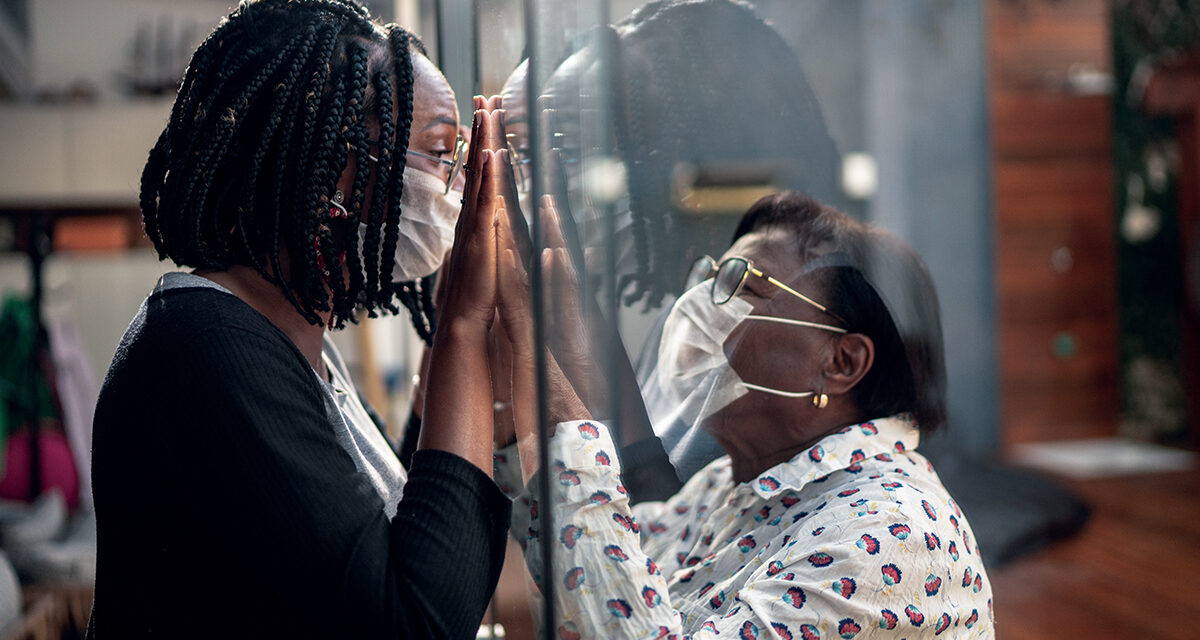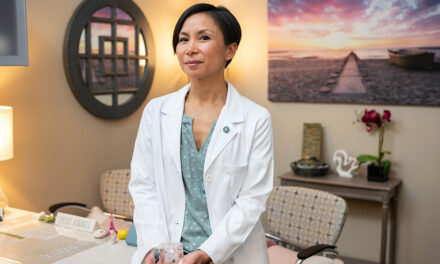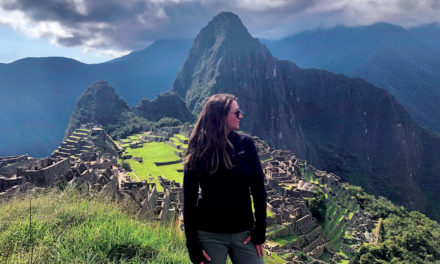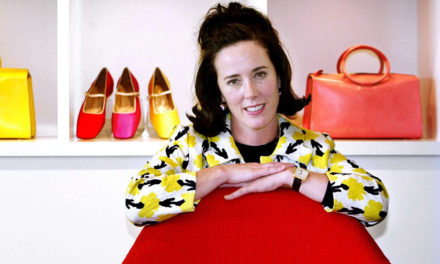Anyone who has ever cared for an elderly parent will tell you how hard it is. But doing so in the time of COVID has been emotionally challenging like never before—especially for children and grandchildren whose loved ones were in long-term care communities. Three women look back on the year of the pandemic.
Last March, as the World Health Organization was declaring COVID-19 a pandemic, my mother moved into an assisted-living facility. She had been living in the community’s skilled-nursing floor, recovering from a series of ministrokes that left her weak and with dementia, but she had progressed enough to be able to live on her own with the support of a professional staff. While my mother was fortunate to escape the community outbreaks that plagued nursing homes across the country, she was one of the millions of seniors who struggled with the deleterious effects of isolation brought on by the COVID quarantine. And we, her children, were left helpless and concerned on the outside.
Like most care communities around the country, hers went into lockdown last spring, prohibiting visitors, activities, and group dining. My father had passed away in November 2019, so she spent the spring of 2020 grappling with this profound loss, oftentimes alone. Like many elderly Americans, my mother was technologically challenged, so Zoom calls and FaceTime were generally unsuccessful. My sister bought her a smart TV so she could connect to Netflix and distract herself with her favorite show, The Crown, but she could never remember how to exit the home screen and frequently lost the remotes.
We found crafty ways to visit my mother, like sitting outside her screened-in porch when the weather was nice to chat and slip her desserts and Wawa hoagies (her favorite) through a crack in the screen. We called daily and sent over clothes and other goods she needed. As the positivity rate dropped over the summer, her community allowed formal visits outdoors, so we regularly gathered around a fenced-in patio—her children and gang of grandchildren on one side of the fence, her alone on the other.
Isolation took a toll on my mother, and by the end of August, she started to escape from the building, her attempt to “break out” she told us. She was confused about her location—sometimes it was her childhood home, other times a mall, even far-flung destinations she’d been to with my father years ago. My siblings and I struggled with guilt and debated if we should move her. Because of our work and exposure to the outside world, every one of us put her at risk for COVID-19. Beyond her age, my mother is diabetic with congestive heart failure (to name just a few of her health issues); the virus would have devastated her body.
Ultimately, my mother was hospitalized on a senior psychiatric floor for evaluation to see if she could return to assisted living. With adjusted medication, she went back to her apartment. While the escaping stopped, her confusion remained.
My mother’s cognitive decline is not unusual; research has shown there is a direct correlation between isolation and reduction of external stimuli and worsening dementia for the elderly population. Confinement to their rooms or apartments also led to an increase of depression among seniors, which can in turn increase the risk of high blood pressure, heart disease, and stroke. According to the Centers for Disease Control & Prevention, loneliness and isolation can lead to four times the risk of premature death, a 50 percent increase in dementia, a 20 percent increase in heart disease, and 32 percent increase in stroke.
“Stimulation and human interaction help keep people at peak performance, regardless of the diagnosis,” explains Robert J. Remstein, DO, MBA, an internist with a focus on geriatric medicine, and vice president for Academic Affairs for Capital Health.
Dr. Remstein notes that the stress of the pandemic and the effects of the stay-at-home orders impacted elderly who lived independently as well. “I think the isolation has been more devastating for seniors than for younger people. For those of us who are younger, we have work, we have activities. Even though it may be remote, we can still socialize on Zoom,” he says. “The elderly have been paralyzed by this. They are afraid to go to any store. They are afraid to see friends and family. The social isolation has been devastating. I’ve seen a fair number of seniors become quite depressed, some requiring medication, and paralyzed that they can’t do anything because they are afraid.”

Isolation has been more devastating for seniors than for younger people. For those of us who are younger, we have work, we have activities. Even though it may be remote, we can still social on Zoom. The elderly have been paralyzed by this.
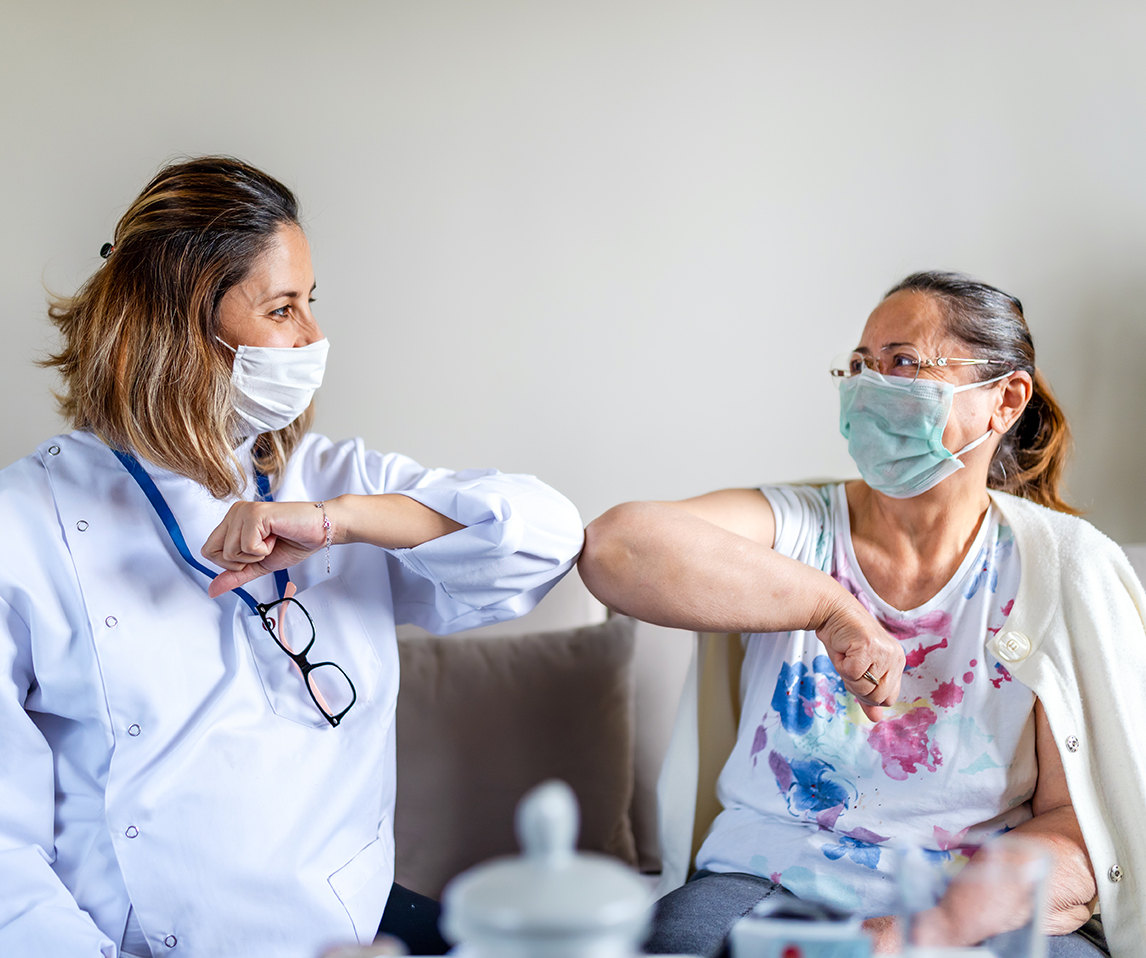
We need to have a more robust infrastructure to be prepared for the next one to recognize a vulnerable population and do whatever we can to keep them safe but also to keep them physically and mentally healthy.
Grief and Guilt
Around the same time my mother was moving into assisted living, Mary Smith* from the Scranton-area of Pennsylvania was caring for her 84-year-old parents, who lived independently. In the midst of the world shutting down, her father, who had Parkinson’s disease, fell, but the EMTs who treated him determined he was okay to stay at home. But over the next 3 days, Smith’s father rapidly declined, unable to stand, get to the bathroom or feed himself.
“[My mother and brother] were up all night with him,” Smith recalls of that late March period. “With advanced Parkinson’s some patients get really bad hallucinations, so he was up all night having night terrors. My mother was hanging by a thread.” Ultimately, Smith urged her father to go to the hospital where he was admitted for observation. “I was hoping that they could get him into some sort of rehab facility,” she says. “He was definitely failing at home.”
Smith masked up and met her father in the emergency room. “When I told him he was being admitted, he was frightened,” she remembers. “He didn’t want to stay; I didn’t know what else to do. My mother couldn’t take care of him. With everything going on with COVID, I was calling trying to get a night nurse, but I couldn’t get anyone to go there and help her. I had to leave him there, and it was awful.”
Smith eventually got her father discharged into a top-notch nursing home nearby for rehab. “I thought he would be safe and well cared for,” she says, knowing that the Catholic-run home would have daily mass, something her deeply religious father would enjoy. Like most families in this situation, Smith and her mother were unable to visit her father during this time, but after a week, they were able to connect via Zoom. Then on May 6, about a month after entering rehab, Smith’s father missed a scheduled Zoom; the nurse was unable to wake him.
Smith had been informed of a COVID case at the facility, but she was told that the patient was in a different wing. “I knew it was there, but I hoped they were handling it.” That day, after the failed Zoom call, the nurse administrator reached out to Smith and told her that her father had had a fever the night before and was tested for COVID. That day and the next, she continuously checked on her father, who seemed to be on the mend. But on Thursday night, the nurse called again to report her father had a 104-temperature and dropping blood pressure. They told Smith and her mother that they could come to see her father, and the home would provide them with personal protective equipment (PPE).
“We went in to see him. He was not struggling. He seemed peaceful,” she recalls of that heartbreaking night. “We were there for a little, and I was trying to talk to him, but he wasn’t responding.” After she and her mom left, they took Smith’s dad to the hospital. He passed away in the early morning of May 8 from COVID-19.
“My mother and I both have so much guilt putting him there, but we put him there thinking he’d be well cared for,” Smith says. “I left him at the hospital, and I never saw him again. I was always trying to take care of them and be really involved in their lives. In the end, it felt like an epic fail. I tried to do the right thing. I thought I made the best decision for everyone.”
Almost a year later, Smith is grieving and supporting her mother. She is grateful that her younger brother, who has an intellectual disability, still lives at home, but she tries to see her mother—safely—as much as possible. “We try to spend time with her carefully and that is hair-raising because it’s like are we helping her or hurting her? But she needs us,” she says. “She can’t run around and see her friends the way she normally would.” So Smith masked up and visited her mother and brother, and once a week had them for dinner, where they sat masked, at opposite ends of a long table. “I thought, I can’t not see her,” she says. “She needs to be with us. I wanted to talk to her about what happened because she needed to talk about it.”
Less than 1 percent of the U.S. population lives in a long-term-care facility, but according to the COVID Tracking Project, they accounted for 35 percent of the COVID-19 deaths in the United States as of February 18, 2021. In Pennsylvania, 50.5 percent of the deaths from COVID-19 were long-term-care residents. In New Jersey, they were 35 percent of the deaths. “What we did to our elderly in nursing homes, we should be embarrassed about forever,” Dr. Remstein says. “We didn’t do enough to protect that population. We didn’t focus early enough on the disproportionate rate of mortality among this population compared to others of a similar age.”
Dr. Remstein says a primary role of public health agencies and government should be to assure that we are better prepared for the next pandemic through the provision of PPE, training, and the tools necessary to meet the sudden demands a pandemic places on organizations such as nursing facilities. One of the lessons learned in this pandemic, he adds, is the need to leverage technology such as tablets and smartphones to allow the elderly to remain in touch with family and friends. Residential facilities, such as nursing homes, need to assure the availability of such technology to their residents, he says. “We need to have a more robust infrastructure to be prepared for the next one to recognize a vulnerable population and do whatever we can to keep them safe but also to keep them physically and mentally healthy.”

Capital Healthy Living
Outside of the disease itself, one of the major health consequences for senior citizens during the COVID-19 pandemic has been the delay of important health care and routine screenings for fear of catching the virus. “I have had a couple of patients with devasting outcomes out of fear of the pandemic,” Dr. Remstein says. “They’ve avoided going to the emergency room with strokes, heart attacks. I had one patient who delayed diagnosis of cancer.”
As the pandemic has shown, access to care is critical for seniors, especially when they want to live independently in their homes. In early 2020, Capital Health piloted a new program, Capital Healthy Living, that made that access easier to come by for senior citizens. The program offers scheduling assistance with Capital Health primary and specialty care providers, transportation through UBER Health or Capital Livery for all appointments, and access to a variety of events and activities through the hospital system.
For the cost of $50 a month, the subscription program starts with a comprehensive assessment to determine the goals, interests, and priorities of the participant to maximize their experience with the membership. Seniors are also paired with a Capital Health Life Care Manager, who is either a licensed social worker or registered nurse and provides follow-up care after doctor’s appointments as well as chronic care for more serious conditions. They can also make all Capital Health medical appointments. Transportation support extends beyond trips to the doctor, allowing for two nonmedical roundtrips per month and four roundtrips to Capital Health social events and wellness classes a month. In addition to wellness classes and social programs, participants will also receive a consultation with a trainer so they can develop a training regimen.
Beginning of the End
With the turn of the new year, hope seemed to be on the horizon for the country with the approval of two COVID vaccines. And while many in nursing homes and assisted living communities were top of the list to receive the shots, like many aspects of the pandemic, the rollout has been imperfect for seniors living independently. Just scroll through the NextDoor app or Facebook to see post after post complaining about how quickly pharmacy slots fill up or how hard it is to get through to local and county health departments.
“Seniors see the vaccine as their ticket to get back into life,” Dr. Remstein says. “First, it was social isolation and fear of getting the disease and dying alone. Now, you have the problem of there is a way out but I can’t get it. It is really a shame. They can see it, but they can’t cross the finish line.”
One 90-year-old who received both vaccine shots is Lynn Fitzgerald’s mother, a nursing home resident in Pottstown, Pa. After a year of ups and downs, the vaccine comes as a relief. At the start of 2020, her mom was living in a small, family-run assisted-living community. As the year went on, her declining health and a series of falls had her in and out of the hospital. Normally, when an elderly parent is hospitalized, it’s exhausting, but COVID added new levels of frustration. With hospitals prohibiting visitors, Fitzgerald was forced to consult with her mother’s care team by phone. The assisted-living community then decided they could no longer care for Fitzgerald’s mother, which meant finding a skilled-nursing-facility that had a bed and was taking new residents.
Since most long-term-care residences were closed to visitors, that meant surveying them online or through brochures. Add to that the struggle so many families have in affording nursing-home care. The average cost of a semi-private room is almost $11,000 a month in New Jersey and $10,000 a month in Pennsylvania. Patients who cannot afford it can apply for a Medicaid bed, but that requires finding a place that has one open.
Today, her mother is settled in a reputable community and getting good care, Fitzgerald says. The community recently reopened group dining, and they’re beginning activities and haircuts again. In-person visits with family are next. But, she says, “Her dementia got so much worse. We did a Zoom for her 90th birthday in July, and she knew all her kids and even her brother and a girlfriend. Now, 2 weeks ago, she didn’t know two of my brothers. She thinks she is in Syracuse.”
Still, Dr. Remstein says the senior generation is resilient. “This is a population that has been through lots of issues throughout their lives,” he says. “There will be some PTSD, but I think they will work their way through it.”
He adds that once your elderly loved one has been fully vaccinated, you can absolutely visit them, but if you have not been vaccinated, continue to wear a mask and social distance. In March, the CDC issued new guidelines for vaccinated Americans, which included okaying two fully vaccinated people to hug. “Touch is so important. We forget the value of that,” Dr. Remstein says. “What you will bring to them is the value of closeness they have been lacking.”

